
This blog was created because I'm very much concerned about our Planet and the many environmental issues which deserve being known by everybody. Some are real catastrophes while others are achievements of great importance for the survival of numerous endangered species or the health of the only planet we've got: E A R T H !
To my dear visitors and commenters
Hi, everybody!
I've noticed with lots of joy and happiness, that thousands of comments have been written in my posts. It's wonderful that so may people around the world appreciate my work. Therefore, I want to thank you for that and ,at the same time I want to ask you to be this blog's followers. It's fast and easy!
Make it be even more visited and spread all over the world! I'm a woman, a teacher of English in Portugal, and I've been away for quite a long time because of my father's health.
Unfortunately he died from Covid19 a few months ago. Now I felt it was time to restart my activity in this and other blogs I owe. I've recently created a new one in a partnership with a street photographer, Mr. Daniel Antunes. He's fabulous!
https://pandpbydandd.blogspot.com
I'd like you to visit it and, who knows, become our followers. The poems, chronicles and thoughts are all mine.
Thank you so much!
Kisses :-)
Search This Blog
Saturday, December 31, 2016
Thursday, April 07, 2016
The island in Cancun built on recycled plastic bottles

A British man in the Mexican tourist area of Cancun is looking to get legal recognition for the island home that he has built almost entirely out of recycled materials.
Richard Sowa created the island in 2007 out of reclaimed wood, held up on a bed of thousands of empty plastic drinks bottles.
He says it is ''a way of turning the trash of the world into paradise''. (from BBC News)
Etiquetas:
Amazing ideas
,
Important measures to preserve nature
,
inventions
,
News from the American continent
,
Recycling
,
SPECIAL VIDEOS
,
unusual events
War threatens world's largest gorilla
Numbers of the world's largest type of gorilla, the Grauer's gorilla, have fallen dramatically.
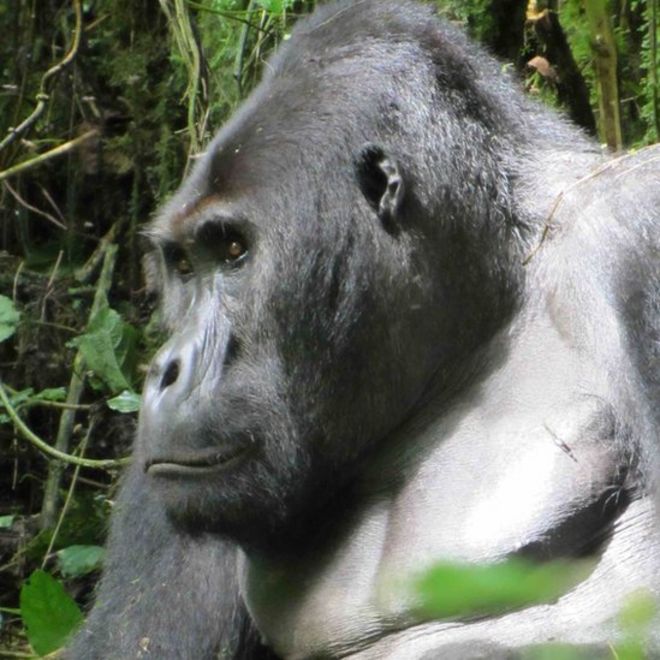
The gorilla is now considered "critically endangered" which means they might soon be totally wiped out.
Where do they live?
The gorilla lives in the eastern part of the Democratic Republic of Congo, in central Africa.
The number of gorillas there has fallen from 17,000 in 1994 to just 3,800 today.
Why is it happening?
War in the the Democratic Republic of Congo has affected the number of Grauer's gorillas living there.
The forests where they live are being destroyed because of the fighting.
They have also been illegally hunted for their meat because in some areas there is not enough food to eat.
From CBBC Newsround
Etiquetas:
Africa
,
Animals
,
Endangered species
,
Extinction
,
war consequences
Cutting food and carbon waste-lines for healthy climate
Reducing food waste and changing the way people consume calories will help deliver a sustainable food system and reduce emissions, a study suggests.
An estimate one third of all food produced remains uneaten
The global demand for food could more than double by the middle of the century, yet an estimated one third of produce is lost or wasted each year.
By cutting this waste will help food security and reducing agriculture's climate burden, the researchers added.
The findings appear in the journal Environmental Science & Technology.
As the global human population is set to reach in excess of nine billion people by the middle of this century, up from the current seven billion, the importance of reducing food loss and waste in order to deliver food security is well documented.
However, a team of scientists have also considered what steps need to be taken to tackle food production's contribution to global carbon emissions.

Shifts in lifestyle and diet is increasing the global impact of the food sector
Prof Jurgen Kropp from the Potsdam Institute for Climate Impact Research, Germany, one of the study's co-authors said that previous studies had highlighted that "agriculture was playing an increasingly important role when it came to carbon dioxide emissions".
"We have worldwide lifestyle changes where people are moving towards a meat-rich diet and we need more food, of course," he told BBC News.
"The more rich a country becomes, there is a move towards more meat-rich diets and, of course, more calorie-rich diets.
"For one calorie of meat, you have to utilise one to eight calories of cereal. It is an inefficient form of food production," he observed.
"On the other hand, rich countries are wasting more food. A lot of the food we are producing at the moment, we do not see on our plates."
Prof Kropp added that this trend was projected to have a considerable impact on the global carbon budget by the middle of the 21st Century.
They calculated that about 10% of global greenhouse gas emissions from agriculture could be traced back to food waste by 2050.
However, the team examined past datasets and used future scenarios to identify pathways that could deliver improvements in food security and CO2 emissions.

As people around the globe shift to more meat-rich diets, emissions from agriculture continue to rise
The team observed: "The global food requirement changed from 2,300 [calories per person each day] to 2,400 [calories per person each day] during the past 50 years, while the food surplus grew from 310 [calories per person each day] to 510 [calories per person each day]."
Over the same period, the team found that greenhouse gas emissions associated with food surplus increased from 130 million tones of CO2 equivalent per year to 530 million tonnes - an increase of more than 300%.
Future scenarios did not make comfortable reading. They calculated that emissions associated with the food wasted may "increase tremendously" to up to 2.5 giga-tonnes of CO2 equivalent per year.
Prof Kropp added: "As many emerging economies like China or India are projected to rapidly increase their food waste as a consequence of changing lifestyle, increasing welfare and dietary habits towards a larger share of animal-based products, this could over proportionally increase greenhouse-gas emissions associated with food waste [while] undermining efforts for an ambitious climate protection.
"Avoiding food loss could pose a leverage to various challenges at once, reducing environmental impacts of agriculture, saving resources used in food production, and enhance local, regional, and global food security."
From BBC News Science / Environment
Sunday, April 03, 2016
'Drastic' Antarctic melt could double global sea-level rise
Global sea levels could rise by more than double the current best estimate, according to a new analysis of climate change in Antarctica.
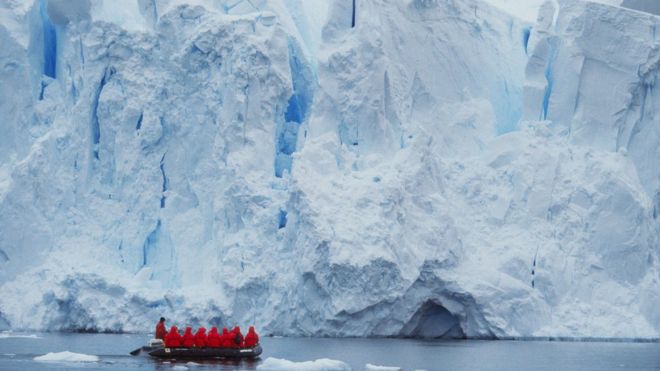
The latest model suggests that Antarctic melting could double projections of sea-level rise
The modelling assessment says that Antarctic melting alone could contribute more than a metre to sea level by the end of this century.
By 2500, according to the study, the same source could cause levels across the world to rise by 13m.
The authors say that rapid cuts in carbon emissions could limit this risk.
Competing ideas
In 2013, the Intergovernmental Panel on Climate Change (IPCC) predicted that, without any restrictions on carbon emissions, the seas around the world likely rise by up to 98cm by 2100.
However, the IPCC estimates contained a minimum contribution from Antarctica.
Other analyses since then have projected bigger increases, with a recent studysuggesting that the oceans were rising faster than at any time in the past 2,800 years and by 2100 they could be up to 1.31m higher.
The exact level of Antarctica's impact on these projections has been vigorously debated. Late last year, a research paper suggested that projections of a contribution of a metre or more were not plausible.
But this new study argues that by 2100 the world could see 1.14m of sea-level rise from Antarctica alone.
Additions to the model
The scientists say that their model is able to provide a more accurate prediction because it incorporates the impacts of some physical processes for the first time.
While other models have focussed on the impact of warmer waters melting the ice shelves from below, this new study also includes the effect of surface melt-water and rain trickling down from above and fracturing supporting ice, hastening its slide to the sea.
The model also calculates the impact of the disintegration of floating ice shelves. If this happens, it will reveal walls of ice so tall that they cannot support their own weight.
The scientists involved expect that these extra factors will kick in over the coming decades, as warming from the atmosphere (not just from warmer waters below) becomes the dominant driver of ice loss.
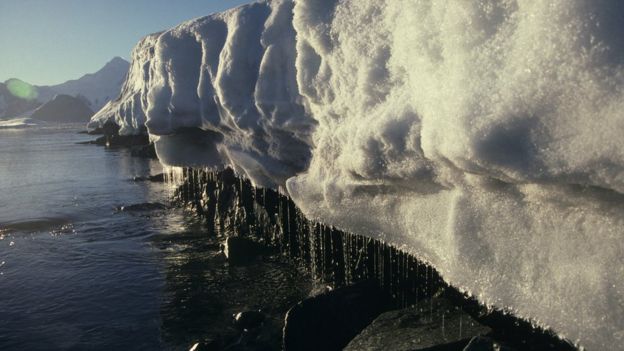
The collapse of ice cliffs could be a significant factor in the new projection
"One reason that other models didn't include the atmospheric warming is because it hasn't started to happen just yet," said co-author Dr David Pollard from Penn State University, US.
"In Antarctica, around the edges at sea level, it's just beginning to get up to the melt point in summer.
"With that warming, the flanks of Antarctica will start to melt drastically in about 50 to 100 years - and then it will start to kick in according to our model."
The authors believe that they have demonstrated the accuracy of the new model by correctly replicating sea-level rise in warm periods, millions of years into the past.
"Recently, we looked at the long-standing problem posed by geological evidence that suggests sea level rose dramatically in the past, possibly up to 10 to 20 metres around 3 million years ago, in the Pliocene," said Dr Pollard.
"Existing models couldn't simulate enough ice-sheet melting to explain that."
'Right questions'
If the world continues to emit "business as usual" levels of carbon dioxide over the coming decades, the scientists argue that sea-level rise will be double what has already been estimated for the coming 100 years.
"If these processes do kick in and they end up being as important as we think that they could be, then they really do have a big impact," said Prof Robert DeConto from the University of Massachusetts, Amherst.
"West Antarctica is responding very soon in these simulations and that ends up having a big impact on North America in particular."
Other researchers have praised the development of the new model for including impacts such as surface melt water and ice-cliff collapse, but they are uncertain about the conclusions.
"I have no doubt that on a century to millennia timescale, warming will make these processes significant in Antarctica, as well as Greenland, and drive a very significant Antarctic contribution to sea-level rise," commented Prof David Vaughan of the British Antarctic Survey.
"The big question for me is, how soon could this all begin, and could it be early enough to drive substantially higher sea levels by 2100? I'm not sure, but these guys are definitely asking the right questions."
The authors believe that there is "good news" in their report. If global emissions of carbon are curtailed significantly then the extra factors that substantially boost Antarctic melting will be avoided.
Seas will continue to rise, but not at the runaway rates suggested by this paper,which has been published in the journal Nature.
From BBC news-Science/ Environment
Etiquetas:
Antarctica
,
Bad news
,
Environmental organizations
,
global warming
,
global warming consequences
,
Informative articles
,
terrible news
,
The importance of oceans
Saturday, April 02, 2016
Number of wild tigers could treble
The number of tigers living in the wild could rise in the next 20 years.
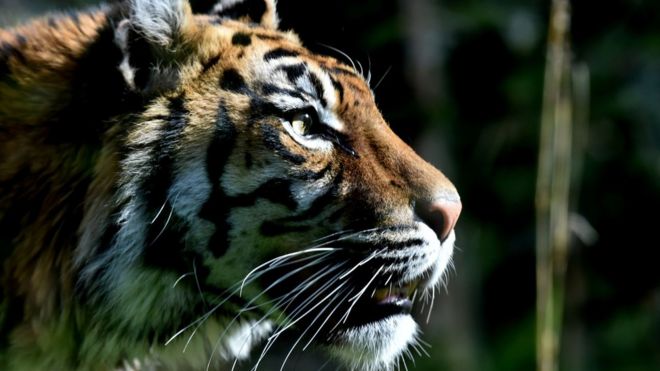
At the moment there are only around three-thousand wild tigers living in Asia. The WWF believe that's 97% fewer than there were 100 years ago. Now experts say that number could treble if action is taken to protect their habitats.
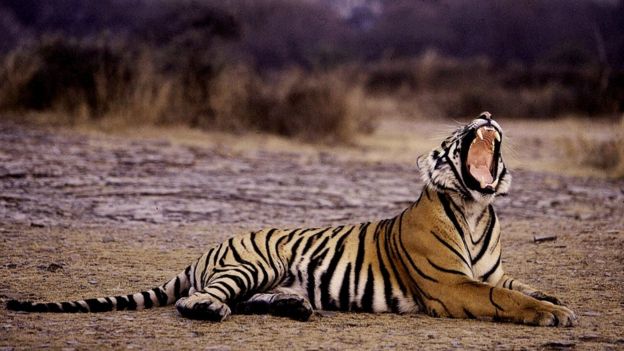
Tigers can be found in 13 different countries around the world
Tiger populations have been affected by hunting, poaching and the loss of their habitats, to make way for roads, railways and towns.
Four of the sub-species of tigers are thought to be endangered and two are listed as 'critically' threatened.
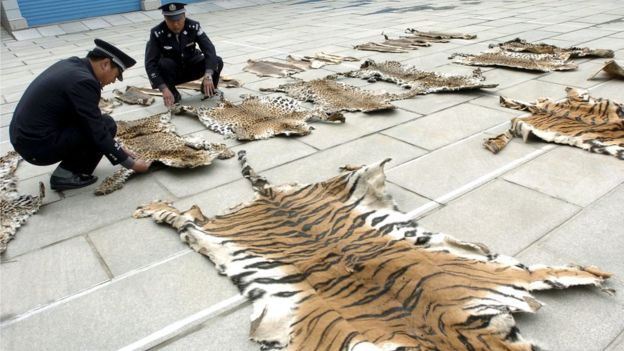
Tigers are poached for their skin, which some people use as decoration or rugs
But experts in the US say the population could grow.
A team at the University of Minnesota in the US have studied satellite images of places where tigers live, like forests.
The technology has helped identify specifically where tigers are losing their habitat.
They say that if the animals are given special 'corridors' or areas to make their territory bigger, the numbers could treble.
Dr Anup Joshi said: " Enough wild habitat remains to allow a range-wide doubling of the wild tiger population."
"The global population could approach a trebling in the next two decades." he added.
From CBBC Newsround
Etiquetas:
Animals
,
Endangered species
,
Extinction
,
Good news
,
illegal poaching
,
illegal trading
,
Important measures to preserve nature
,
unusual events
Friday, April 01, 2016
Climate predicts bird populations
Populations of the most common bird species in Europe and the US are being altered by climate change, according to an international study.
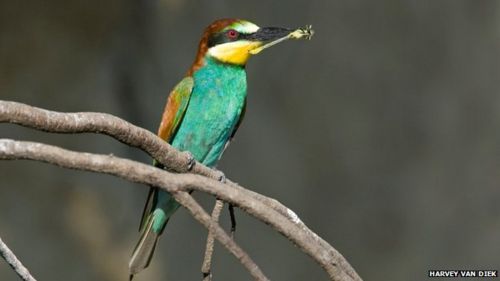
Bee-eaters seem to be benefitting from climate change, increasing their population in Europe in recent years
For the first time researchers showed climate to be having a similar, significant impact on bird populations in large, distant areas of the world.
Their study used population-predicting models and three decades of field data, gathered by bird-watching volunteers.
The findings are published in the journal Science.
Led by Durham University scientists, the team developed models that related each species' habitat to long-term climate patterns.
Using annual climate records - from 1980 to 2010 - these models were able to predict where a species had experienced an improvement or a decline in suitable climate.

Climate is remapping habitat for many familiar birds, such as the wren
"We then had this amazing data set collected by thousands of volunteers over decades - where people have gone out and counted birds across different countries in Europe and the United States," explained lead researcher Dr Stephen Willis.
"We can use that to see to what extent our predictions match what people are finding on the ground."
The outlook is different for each species. Increasing temperatures in the UK, for example, allow some species to expand their range and increase their population, while the same temperature patterns have made the UK a less suitable habitat for others.
But the overall trends, this study shows, are strikingly similar in the US and Europe; populations are increasing in species predicted to benefit from climate change and decreasing in those predicted to be negatively affected.
"One important thing is that we're looking at the most common birds," said Dr Willis. "These birds are doing a lot of good in the countryside - eating crop pests and helping our ecosystems work.
"So we need to understand how they'll respond."
Shifting flocks
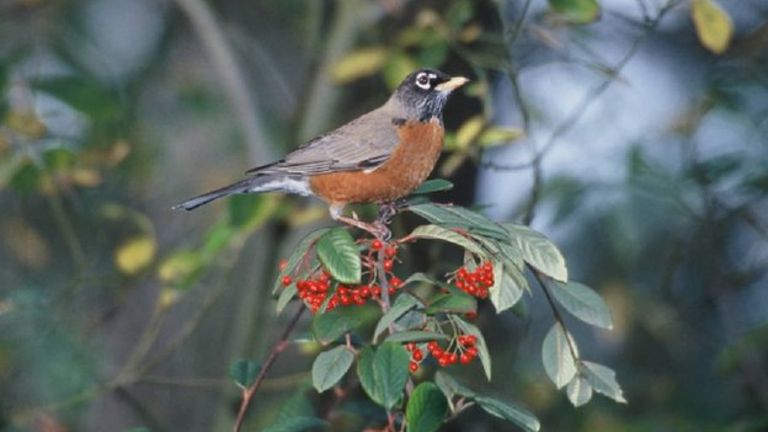
The American robin has declined in some southern states, but increased further north.
The research shows how the climate is gradually remapping the avian habitat across two continents.
In Europe, for example, birds such as the wren have been increasing in northern areas as winters become milder, but declining in some southern countries. The American robin has declined in some southern states, but increased further north.
"This is really the first time anyone's ever looked at changes in climate across two really extensive parts of the world," said Dr Willis. "So we're getting an idea that [the impacts of] climate change on wildlife are more far-reaching than individual countries."
David Noble from the British Trust for Ornithology, who was also involved in the study, told BBC News that the findings highlighted the value of such extensive data sets generated by volunteers.
"The similarities in results between the two continents, despite very big differences in their landscapes, geographic barriers and patterns of vegetation, are compelling evidence for the climate change effects," he added.
Dr Willis agreed, saying: "This is work carried out by thousands upon thousands of volunteers; it really demonstrates the power of citizen science."
The study was carried out in partnership with the RSPB and United States Geological Survey (USGS).
From BBC News- Science/ Environment
Etiquetas:
Animals
,
Birds
,
Climate changes
,
Development and environment
,
global warming
,
global warming consequences
,
Important measures to preserve nature
Monday, March 28, 2016
Ash tree set for extinction in Europe
The ash tree is likely to be wiped out in Europe, according to a review of the evidence.
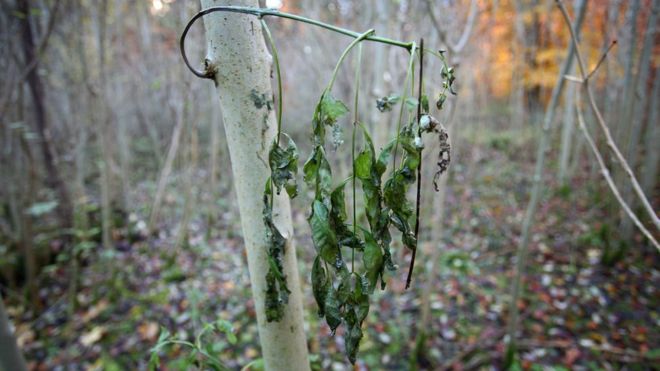
The chalara dieback has devastated ash trees across Europe
The trees are being killed off by the fungal disease ash-dieback along with an invasive beetle called the emerald ash borer.
According to the research, published in the Journal of Ecology, the British countryside will never look the same again.
The paper says that the ash will most likely be "eliminated" in Europe.
This could mirror the way Dutch elm disease largely wiped out the elm in the 1980s.
Ash trees are a key part of the treescape of Britain. You don't have to go to the countryside to see them. In and around towns and cities there are 2.2 million. In woodland, only the oak is more common.
However, according to a review led by Dr Peter Thomas of Keele University and published in the Journal of Ecology, "between the fungal disease ash dieback and a bright green beetle called the emerald ash borer, it is likely that almost all ash trees in Europe will be wiped out - just as the elm was largely eliminated by Dutch elm disease".
Ash dieback, also known as Chalara, is a disease that was first seen in Eastern Europe in 1992. It now affects more than 2 million sq km, from Scandinavia to Italy.
UN: 2015 record year for global renewables investment
Global investment in renewable energy hit a record US$285.9bn (£202.3bn) in 2015, beating the previous high of $278.5bn set in 2011, a study shows.
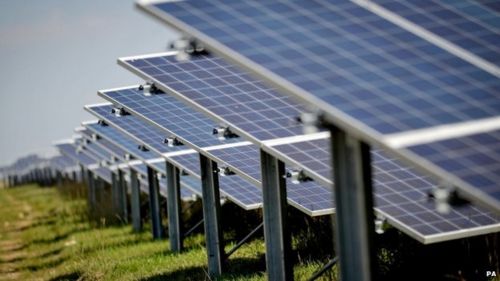
The solar and wind industries remain the driving force behind the growth in investment in the global renewable energy sector
The 10th Global Trends in Renewable Energy Investment also showed that investment in developing nations exceeded that in developed countries.
In another first, more new renewables capacity than fossil-fuel generation came online during 2015.
But it warned that much more had to be done to avoid dangerous climate change.
The assessment, produced by the Frankfurt School-Unep Collaborating Centre for Climate and Sustainable Energy Finance and Bloomberg New Energy Finance, showed that the developing world committed a total of US$156bn (up 19% on 2014 levels) in renewables (excluding large hydro) while developed nations invested US$130bn (down 8% from 2014 levels).
"A large element in this turnaround was China, which lifted its investment by 17% to US$102.9bn, or 36% of the world total," the report observed.
However, other developing nations also contributed as six of the top 10 investors were developing nations.
In the foreword, UN secretary-general Ban Ki-moon said the report's findings increased confidence that a low-carbon world was obtainable.
He wrote: "We have entered a new era of clean energy growth that can fuel a future of opportunity and greater prosperity for every person on the planet."
However, he warned that in order to avoid dangerous climate change required an "immediate shift away from fossil fuels".

At the Paris climate talks, nations agreed to decarbonise the global economy by the end of the 21st Century
UN Environment Programme Finance Initiative's Eric Usher, one of the assessment's co-authors, said the findings were, overall, positive and seemed to indicate that a shift was occurring.
"Renewables investment is at a new high, and investment is shifting geographically with developing countries investing more than developed countries for the first time (55%/45%)," he observed.
However, he did add that there were areas that caused concern when the focus shifted to regional or national levels.
"There is a still a lot of uncertainty, especially within Europe, with a degree of policy backtracking or the phasing down of support for the (renewables) industry," he told BBC News.
Fellow co-author Ulf Moslener, head of research at the Frankfurt School-Unep Centre, said the latest figures indicated that shifts in attitude, as well as structure, were occurring.
"This level of investment means... more than half of the capacity added to the global energy mix is renewables-based," he said.
Prof Moslener added that renewable generation was still dwarfed by fossil fuel-based sources, and only accounted for 10% of the global mix.
"That shows us that we are quite far from having a system that is based on renewables," he told BBC News.
Lead author Angus McCrone, chief editor at Bloomberg New Energy Finance, said that although global oil prices had fallen sharply recently, the cost of generating electricity via renewables had also decreased significantly, adding that there were also other factors that made the industry attractive to investors.
"One advantage that renewables has is that it can be built very quickly," he explained.
"If you are a power-hungry emerging market in Africa or South America, for instance, you can put up a wind farm in six to nine months, or a solar plant in three to six months.
"However, if you want to put up a coal-fired power station, it is going to take three or four years. A nuclear power plant is going to take substantially longer than that."
Etiquetas:
Clean energy sources
,
Solar energy
,
Summits
,
technology
Friday, March 25, 2016
HAPPY EASTER TO ALL!

Mª Dulce Branquinho
Etiquetas:
Celebrations
,
Easter
Thursday, March 24, 2016
Turtles in trouble as warming beaches turn eggs female
Can you imagine if the temperature decided whether you were born a girl or a boy?
From CBBC Newsround

Well that's exactly what happens with turtles.
But experts in Australia are now worried that rising temperatures over time could cause chaos for turtle populations by creating too many female turtles.
Researchers investigating the impact of rising temperatures on sea turtles are travelling to some of the most remote beaches in Australia to work out which populations are at risk of being feminised into extinction.
In a phenomenon being seen worldwide, warming temperatures are resulting in an increasing number of turtle eggs hatching female.
The race is now on to work out which rookeries are most at risk in Australia, with a University of Western Australia (UWA) team focused on turtle breeding areas on the Kimberley coast.
"This is very fundamental research, and will give us insights fifty years ahead about whether sex ratios will change, where distributions might shift to, and what impact climate change is going to have," team leader Nicki Mitchell said.

The tipping point for sex determination in turtles is thought to be just over 29 degrees Celsius. If the beach sand is any warmer the incubating eggs will hatch female, however if it is any cooler, the hatchlings will be male.
The problem is that beaches are heating up across much of the globe, and that could have big implications for turtle rookeries.
Researcher Blair Bentley said whole populations could be at risk.
"If it keeps getting warmer there are going to be more females being produced, and over time the males will keep dying at a greater rate than they are being replenished, so it's what's called demographic collapse," he said.
"There might still be males in the population, but there'll be far more females, and reproductive success will go down significantly."
Etiquetas:
Animals
,
Endangered species
,
Extinction
,
global warming consequences
,
Important measures to preserve nature
,
Informative articles
,
The Great Barrier Reef
,
The importance of oceans
Friday, March 18, 2016
Great Barrier Reef coral 'bleaching' level increased
Authorities in Australia have raised the threat level for coral 'bleaching' in the Great Barrier Reef, after divers found that lots of coral had died.
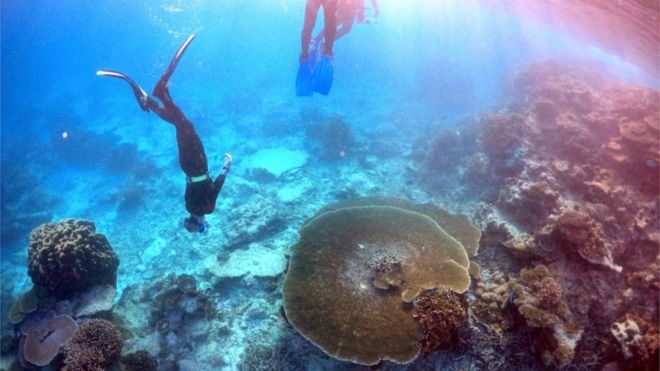
The Great Barrier Reef is the world's largest living structure, and is home to thousands of plants and animals - it is so big it can even be seen from space.
Divers have found that an increase in the sea's temperature has been putting the coral which grows there under a lot of stress causing 'bleaching', which means a loss of colour.
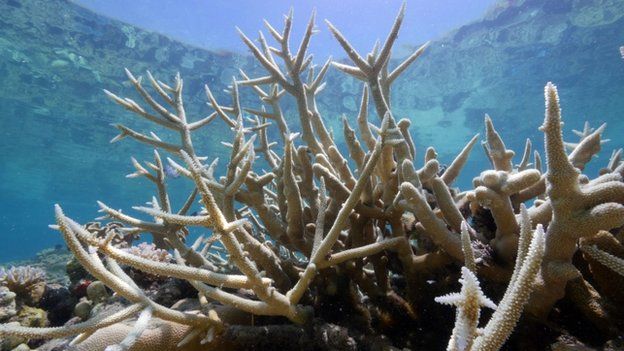
What is bleaching?
Many types of coral have a special relationship with tiny algae that live in the coral.
These tiny algae produce about 90% of the food the coral needs to grow, and give them their bright colours.
Bleaching happens when sea temperatures get too high or low, causing the algae to get 'stressed out' and leave the coral.
This turn the coral white and leaves it very vulnerable.
An increase of just one degree Celsius for four weeks can cause bleaching. If this continues for more than eight weeks, the coral can die.

Has this happened before?
In 2002 the surface temperature of the sea water in the Great Barrier Reef increased by around 2-3 degrees causing one of the worst bleaching incidents on record, affecting more than 60% of the coral.
While some coral reefs can recover from bleaching in a few years, others don't recover at all.
The Great Barrier Reef Marine Park Authority have now raised the bleaching threat level, and have said that there is a very high risk of mass coral bleaching this month.
The Australian government said it is working closely with the marine rangers to help keep an eye on the coral for the next few months to see how it is doing.
From CBBC Newsround
Etiquetas:
Australia
,
Climate changes
,
Endangered species
,
Environmental disasters
,
Extinction
,
global warming consequences
,
terrible news
,
The Great Barrier Reef
,
The importance of oceans
Sunday, March 13, 2016
Europe's rarest seabird 'faces extinction'
Europe's rarest seabird will be extinct within 60 years, according to a new analysis.
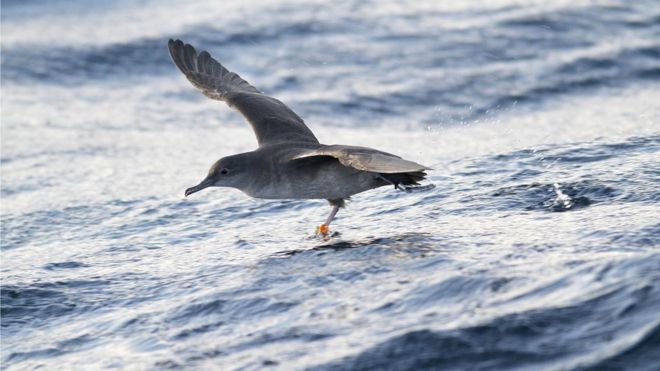
The bird breeds in caves off Mallorca
Urgent action is needed to stop the Balearic sheerwater being drowned in fishing lines and nets, say scientists.
The bird breeds in the Balearic Islands, sometimes stopping off in British waters as it migrates north.
Research shows the global population is not sustainable in the long term. There are about 3,000 breeding pairs left.
The main threat to the bird is becoming entangled in fishing gear, according to findings published in the Journal of Applied Ecology.
Other risks include hunting by the likes of cats and other small mammals.


Prof Tim Guilford of the Department of Zoology at the University of Oxford is co-researcher on the study.
He told BBC News: "The survival of adults from one year to the next and especially of young adults is much lower than we thought.
"The species is unsustainable - it is on the road to extinction."
Night fishing
Estimates suggest about half of deaths in adult birds are due to accidental capture in fishing lines and nets.
Fishing on the seabed is a particular risk as birds can become entangled and drown when lines are immersed, say researchers in the UK and Spain.
Changes such as setting fishing gear at night when the bird does not dive "could make a massive difference", said Prof Guilford.
"The science shows just how serious the problem is, but also that there is a technically simple solution - the setting of demersal long-lines at night," he added.
The Balearic shearwater (Puffinus mauretanicus) is one of the rarest seabirds in the world.
The seabird is classified as critically endangered on the IUCN Red List of species.
It breeds on cliffs and small islets and lays only one egg.
From BBC News-Science / Environment
Etiquetas:
Animals
,
Endangered species
,
Extinction
,
Important measures to preserve nature
,
National Parks
,
Rare species
,
The importance of oceans
,
The Power of Nature
,
Wonders of Nature
Tuesday, March 08, 2016
Climate deadline looms for African food crops
Researchers have produced a timescale of how projected climate change is set to alter the face of agriculture in Sub-Saharan Africa.
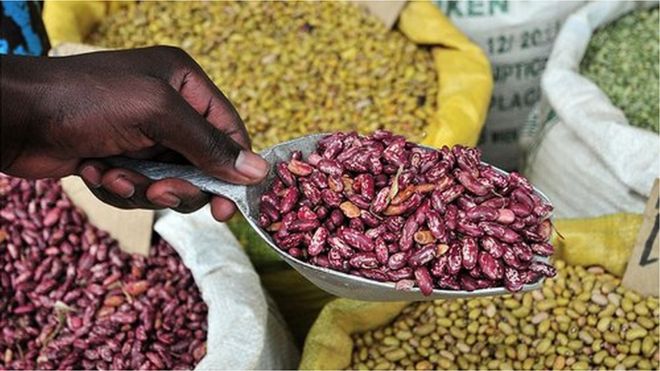
Beans are sensitive to night-time temperatures, making them particularly vulnerable to climatic changes
Climate change is widely projected to have a significant adverse impact on food security if no adaptation measures are taken, they explain.
In their study, the team provides timings of the "transformations" needed to help minimise these impacts.
The findings have been published in the journal Nature Climate Change.
Agricultural activities are considered to be one of the main drivers to reduce poverty and improve food security among the planet's undernourished population, which is estimated to be 800-850 million people.
Climate change is widely expected to have a destabilising effect on food production systems, the authors observe, and previous studies have concluded that adaptation "will be required if food production is to be increased in both quantity and stability to meet food security needs during the 21st Century".
Co-author Julian Ramirez-Villegas from the University of Leeds, UK, said the study carried out by the CGIAR research programme on Climate Change, Agriculture and Food Security (CCAFS) set out to quantify for the first time when changes to food production were likely to happen.
"Rather than focusing on what we need to do by a certain time, we know that there is a range of options and then we put deadlines on these options," he told BBC News.

The team assessed when areas growing nine of Sub-Saharan Africa's staple crops - which account for half of the region's food production - would have to undergo "transformational adaptation", which refers to a fundamental shift in an area's food production system. For example, stop growing crops and switch to livestock farming instead.
Dr Ramirez-Villegas said the study found that six of the nine crops assessed were "stable in respect to transformation and adaptation".
"It does not mean there will not be impacts, for example the yields might decrease," he added.
"But there are three - beans, maize and bananas - that are more unstable and are therefore projected to have large amounts of area under transformational change.
"In the case of beans, in particular, we see about 60% of the area in need of transformation and adaption (under a high warming scenario - +3.0C/5.4F) because the climate shifts away from the conditions were you can actually grow the crop."
'Climate-smart' crops
However, he added that it was not all bad news as technological advancements offered hope of increasing resilience to changes in the growing conditions.
One example was "climate smart" crop varieties. In 2015, researchers reported a breakthrough in the development of temperature-resilient beans that could help sustain a vital source of protein for millions of people around the globe.
"Also, in the longer term, where transformation is unavoidable, you can shift crops," Dr Ramirez-Villegas explained.
"Just because people are no longer able to grow one crop, it does not mean that people have no options. In most cases, we find that there are alternative crops that remain suitable for those places."
He said the team found that there were only "very specific pockets" where farmers would have to shift away from the nine staple crops that were assessed in the study.
"In those cases, livestock might constitute an alternative livelihood option, or people might completely change their livelihood by migrating, for example, or by completely changing the land-use," he suggested.
In order to maximise the options available to farmers to cope with projected climatic changes, Dr Ramirez-Villegas said that there were two areas that needed addressing.
"We need to work on the barriers to the adoption of technologies, as we know that in Sub-Saharan Africa, adoption levels are sometimes low," he observed.
"What we also need to do is to put planned adaptation into national development plans."
In a separate study, published in The Lancet, researched warned that climate change could be responsible for more than half-a-million deaths by the middle of the century.
The research was described as the strongest evidence yet that "climate change could have damaging consequences for food production and health worldwide".
From BBC Science / Environment
Subscribe to:
Posts
(
Atom
)
Wikipedia
Search results

